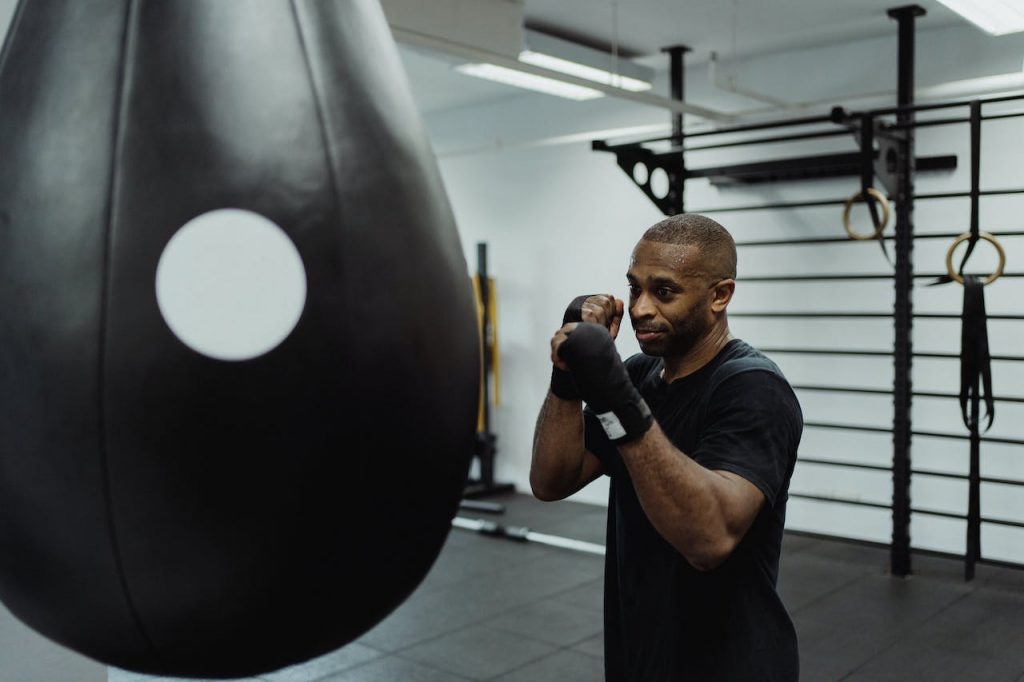
Fine-Tuning Fight Skills with Punching Bags
Punching bags have been a cornerstone of fight training for centuries, refining combat skills and building resilience. But how do these seemingly simple fitness equipment fine-tune your fighting abilities? From enhancing striking precision to improving footwork and agility, punching bags offer a holistic approach to honing fighting techniques.
Whether you’re an aspiring boxer or a seasoned martial artist, the impact of consistent bag work is undeniable. In this post, we’ll delve into the multifaceted benefits of punching bags in sharpening your fighting prowess.
Benefits of Punching Bag Training for Fighters
Improved Cardiovascular Fitness and Endurance
Punching bag training is an excellent way for fighters to boost their cardiovascular fitness and endurance. The constant movement, punching, and footwork involved in bag work elevate the heart rate, promoting better blood circulation and oxygen delivery throughout the body. This type of high-intensity interval training helps fighters develop stamina, allowing them to sustain peak performance during long bouts or intense training sessions.
Moreover, continuous practice with a punching bag can lead to improved breathing efficiency. As fighters engage in rapid movements and strikes, they naturally enhance their lung capacity. This means that they can take in more oxygen with each breath and expel carbon dioxide more effectively. Ultimately, this results in increased overall endurance during fights or sparring matches.
Read Also: Cognitive Benefits of Speed Bag Training
Enhanced Hand-Eye Coordination and Timing
Another significant benefit of using a punching bag is the improvement it brings to a fighter’s hand-eye coordination and timing. When hitting the bag repeatedly while focusing on specific targets or patterns, fighters sharpen their ability to coordinate their hand movements with what they see.
This skill is crucial during actual combat scenarios as it allows fighters to accurately land punches on opponents while evading incoming strikes.
Practicing combinations on the punching bag helps fighters refine their sense of timing. They learn how to gauge distances accurately when delivering punches or moving around an opponent. This precision becomes invaluable when trying to exploit openings in an adversary’s defense or launching effective counterattacks.
Punching Bag Exercises for Strength and Conditioning
High-Intensity Interval Training (HIIT)
High-intensity interval training, or HIIT, is a powerful method to maximize calorie burn during your punching bag workout. By incorporating short bursts of intense activity followed by brief rest periods, you can elevate your heart rate and boost your metabolism.
For instance, alternating between punching at full speed for 30 seconds and taking a 15-second break can significantly enhance the effectiveness of your workout routine. This not only improves cardiovascular endurance but also contributes to overall strength building.
Utilizing HIIT with the punching bag allows fighters to simulate the intensity of a real fight while developing stamina and explosiveness. The rapid succession of punches engages various muscle groups in the arms, shoulders, back, and core.
As a result, this type of training helps fighters fine-tune their fight skills by enhancing their ability to sustain high levels of effort over extended periods.
Varied Punching Combinations
Incorporating diverse punching combinations into your routine is essential for targeting different muscle groups throughout the body. For example, throwing straight punches primarily engages the muscles in the arms and shoulders while incorporating hooks or uppercuts activates muscles in the core and back.
Read Also: Boxing Speed Bag Training Tips and Tricks for Boxers
By practicing an array of punches, fighters can effectively strengthen multiple areas simultaneously during their punching bag workouts.
Implementing varied punching combinations also promotes coordination between different muscle groups as well as enhances overall body control when executing complex movements during fights.
Effective Heavy Bag Workouts for Skill Improvement

Practice Defensive Techniques
When using a punching bag, you can practice essential defensive techniques like slips, rolls, and blocks. By simulating an opponent’s movements, you can work on your timing and positioning to avoid incoming punches. For example, when the bag swings towards you, practice slipping to the side or rolling under it. This helps improve your ability to evade strikes during a real fight.
Moreover, focusing on these defensive maneuvers also enhances your overall footwork and balance. As you move around the bag while practicing these techniques, you’ll develop agility and stability in different stances.
Precision and Accuracy
A crucial aspect of honing fight skills with a punching bag is aiming for specific target areas with precision and accuracy. By targeting specific spots on the bag consistently, such as the chin or ribs, you can improve your ability to land effective punches during combat scenarios. This targeted approach not only sharpens your striking abilities but also conditions muscle memory for accurate hits.
For instance, by repeatedly hitting a designated area on the heavy bag with proper form and technique, fighters refine their way of delivering powerful blows precisely where they intend to strike.
Choosing the Right Punching Bag for Your Training
Consider the Weight
When selecting a punching bag, it’s crucial to consider the weight based on your skill level and desired intensity. For beginners or those focusing on speed and technique, a lighter bag around 50-70 pounds is suitable.
More advanced fighters or those aiming to improve power and strength should opt for heavier bags weighing 100 pounds or more. The right weight ensures that you can effectively practice your punches without causing injury.
Determine Filling Material
The type of filling material in the punching bag significantly impacts your training goals. Bags filled with water provide a more realistic feel as they sway like an opponent, enhancing agility and movement training.
On the other hand, sand-filled bags offer resistance throughout each strike, helping to build strength in every hit. Understanding your objectives will guide you in choosing the appropriate filling material that aligns with your specific needs.
Read Also: Tips for Setting Up a Speed Bag at Home for Boxing
Evaluate Hanging Options
When fine-tuning fight skills with a punching bag, it’s essential to carefully evaluate hanging options available for proper installation. Some bags come with chains while others utilize straps or mounts for hanging. Ensure that you have access to sturdy hooks or brackets capable of supporting the weight of the bag securely.
Proper installation not only guarantees safety during training but also maximizes efficiency by allowing unrestricted movement around the bag.
Boxing Drills to Improve Performance Inside the Ring
Shadowboxing Analysis
Shadowboxing in front of a mirror is an excellent way to analyze and refine your technique. By observing your movements, you can identify any flaws or weaknesses in your punches, footwork, and overall form.
This allows you to make real-time adjustments and improvements as you practice. For example, if you notice that your stance is too wide or your punches are not straight enough, you can immediately correct these issues.
Utilizing combination drills during shadowboxing helps simulate real fight scenarios. Practicing various combinations of punches and footwork enables boxers to develop their ability to seamlessly transition between offensive and defensive moves during a fight. By incorporating different combinations into training sessions, boxers can enhance their muscle memory for specific sequences of movements that are crucial inside the ring.
Partner Sparring
Sparring with a partner is an essential part of training for any boxer as it enhances reaction time and defensive skills. It provides practical experience in reading an opponent’s movements, understanding timing, maintaining distance from strikes, and developing effective counterattacks. Partner sparring also helps boxers recognize bad habits they may have developed during solo training sessions or when using punching bags.
Closing Thoughts
You’ve now got the lowdown on how punching bags can take your fighting skills to the next level. From boosting your strength and agility to honing your technique, these bad boys are a game-changer for any fighter.
So, what are you waiting for? It’s time to lace up those gloves, unleash your inner warrior, and show that punching bag who’s boss!
Ready to elevate your training and dominate in the ring? Get yourself a punching bag, throw on your wraps, and start throwing those punches. Your journey to becoming a force to be reckoned with starts now!
